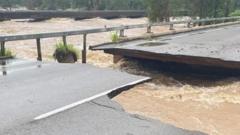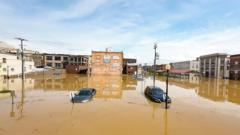Queensland is grappling with unprecedented flooding that has claimed lives and severely damaged infrastructure, while authorities brace for continued rainfall and rising waters.
Australia Faces Catastrophic Floods as Infrastructure Crumbles

Australia Faces Catastrophic Floods as Infrastructure Crumbles
Severe flooding in Queensland leads to highway collapse and tragic loss of life.
Sections of a major highway in Queensland have partially collapsed amidst the devastating impact of ongoing floods. The torrential rains, which have so far resulted in the tragic death of one individual and forced thousands to evacuate, have particularly affected communities in Townsville, Ingham, and Cardwell. The Bureau of Meteorology has reported that the area received a staggering 1.3 meters (4.2 feet) of rain since Saturday, with more expected, raising alarms about overflowing dams and rivers.
Prime Minister Anthony Albanese has commended the Australian spirit of resilience, stating, “I’ve seen Australians helping one another in their time of need,” via a post on social media platform X. He cautioned that the threat from floodwaters would remain for several days in the affected regions. Rescuers are finding it difficult to reach the hardest-hit areas, with portions of the Bruce Highway—a vital transport route linking Brisbane to northern Queensland—experiencing significant damage and a bridge collapse. According to the Queensland Trucking Association, this disruption could increase travel distances for essential deliveries by 700 kilometers (434 miles).
Queensland Premier David Crisafulli expressed condolences to the community of Ingham, where a 63-year-old woman lost her life during a rescue attempt when the State Emergency Service (SES) dinghy overturned. He plans to visit the flooded areas and advised residents in severely impacted zones near the Ross River not to return home due to ongoing hazards.
The Australian Bureau of Meteorology revealed that the torrential rain has produced six months' worth of precipitation in a mere three days, leading to warnings of potential inundation affecting around 2,000 homes, some of which could see water levels rise to the second floor.
Despite meteorologists indicating that the deluge may be easing, major flood warnings are still in place for numerous rivers across the area, and emergency workers are tirelessly responding to calls for help, with the SES managing 480 requests for assistance overnight. Many communities remain without power, complicating efforts to deliver aid.
With north Queensland particularly susceptible to destructive weather, experts have raised alarms about more frequent and intense extreme rainfall events attributed to climate change. This flooding event is predicted to be one of the worst the region has faced in over six decades, reflecting the urgent need for sustainable infrastructure and emergency preparedness.





















